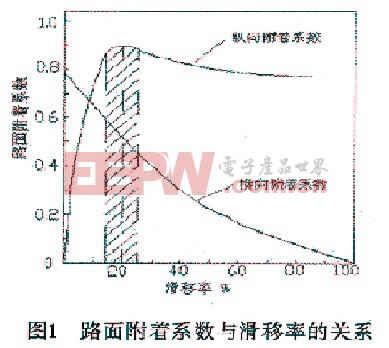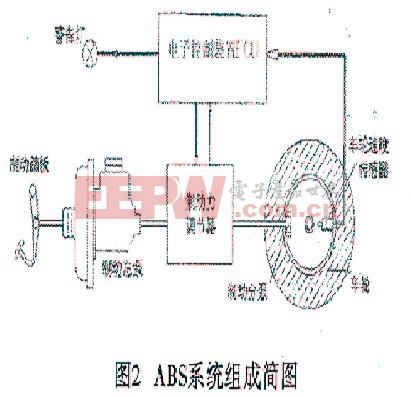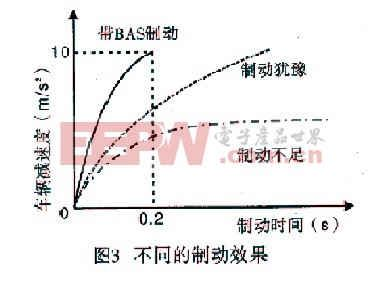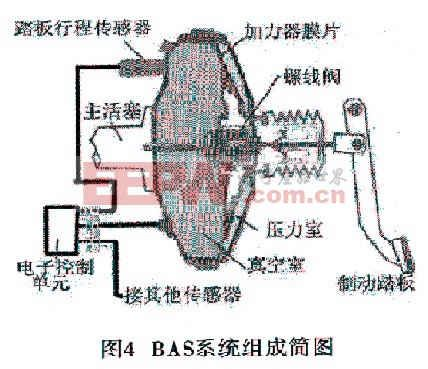Vehicles have two requirements for safety: the first is passive safety, which requires protection of the occupants in the event of a collision, and the other is active safety, which increases the stability of the vehicle and requires accident prevention. The use of electronic control technology to improve the performance and expand the functionality of the vehicle's active safety system has been widely used and developed. Modern vehicle electronic control active safety systems mainly include ABS, BAS, ASR (TCS), ESP and so on. This article refers to the address: http:// First, ABS Anti-lock brake system ABS, the English full name Anti-lock Braking System. The stability of the direction of braking means that the car can still travel in the specified direction when braking. When the car is driving at a high speed, it is very dangerous if the wheel is completely unable to rotate due to emergency braking (professional term "wheel lock"). If the front wheel is locked, it will make the car lose its steering ability; if the rear wheel is locked, there will be deviation, slippage and even tailing, which will cause great harm to driving safety. The braking force of the car depends on the friction of the brake, but the braking force that can decelerate the car's brake is also limited by the ground adhesion coefficient. When the braking force generated by the brake increases to a certain value, the car tire will slip on the ground. According to the test, the adhesion coefficient reaches the maximum when the wheel slip ratio is 15% to 20% (Fig. 1). Therefore, in order to obtain the best braking effect, the wheel slip ratio must be controlled at 15%-20. Within the range of %. ABS works by relying on the high-sensitivity wheel speed sensor (and the vehicle speed sensor on the body) mounted on each wheel. Through computer control, once a wheel is locked during emergency braking, the computer immediately commands the pressure regulator to make The brake cylinder of this wheel is decompressed to return the wheel (Fig. 2). The working process of ABS is actually the cycle work of locking → releasing → locking → releasing. The brake can act 60 to 120 times in 1s, which is similar to the “point brake†action of mechanical automation, making the wheel The gap rolling state is always in a critical lock (the wheel slip ratio is in the range of 15% to 20%, that is, the shaded portion of Fig. 1). Thereby increasing the braking deceleration and shortening the braking distance, but the most important thing is to overcome the side slip and the deviation, to ensure the directional stability of the car, and to prevent the body from running out of control. The above describes the single-parameter (wheel speed) control ABS, and a two-parameter (wheel speed, vehicle speed) control ABS, which adds a vehicle speed sensor speed radar). This kind of ABS can guarantee the ideal control of the slip ratio, and the anti-lock braking performance is good. However, due to the addition of a speed measuring radar, the structure is complicated and the cost is high. According to the ACEA (European Association of Vehicle Manufacturers) survey, every new car produced in Europe today is equipped with an ABS system, and more than 60% of new cars worldwide have this device. In China, the "Technical Conditions for Safe Operation of Motor Vehicles" (national standards) promulgated in 2005 stipulates: "From October 1st, long-distance buses and tourist buses with a total mass greater than 12000kg, the total mass of more than 16000kg allowed to be attached is greater than the total mass. For 10,000kg trailer trucks and trailers with a total mass greater than 10000kg, ABS must be installed in accordance with GB/T13594." Second, BAS Brake Assist System BAS, English full name Brake Assistant System. BAS is a powerful complement to ABS. In an emergency, even if the driver reacts quickly, the driver often cannot apply enough pressure to the brake pedal, or hesitate to make the full brake too late or even react incorrectly. As shown in Figure 3, if the brake pedal is pressed down with a small force, it takes a long time to fully brake, and the brake stroke is longer, which is called insufficient brake; if it is used in the early stage of braking A small brake pedal force, and the increase of this force is very slow, which also makes the brake effect lag, which is called brake hesitation; and the braking effect assisted by BAS is very different, the braking effect is quickly effective. , greatly shortening the braking distance. Based on the strength and speed at which the driver steps on the pedal, the BAS increases the braking force in a timely manner, providing an effective, reliable and safe brake. The BAS electronic control unit receives the input signal from the engine electronic control module ME, the traction system control module, the BAS pedal stroke sensor, the BAS release switch, etc., and outputs the signal to the BAS solenoid valve and the BAS indicator. The electronic control unit determines its control mode according to the input signal: 1 If the speed of the driver's stepping on the brake pedal does not reach the specified value of the starting BAS, the solenoid valve in the BAS brake regulator is in a basic position, at this time Normal operation mode; 2 When the driving speed is higher than 8km/hld, the brake pedal speed satisfies the condition of the activation system, the electronic control unit activates the solenoid valve, and the solenoid valve immediately pressurizes the pressure chamber and the vacuum chamber, thereby applying the maximum brake pressure, This process can occur even if the driver only presses the brake pedal a little or fails to apply maximum pressure (Fig. 4). Since the anti-lock braking system continues to accurately calibrate the braking force according to the sliding coefficient, so that the driver can still control the driving of the car, the wheel will not lock during the automatic emergency braking; 3 when the driving speed is less than 3km/h Or when the BAS continues to work for more than 20s, the BAS pressure is weakened. If the driver removes his foot from the brake pedal, the dedicated pressure reducing device closes the solenoid valve and immediately stops the automatic assist. BAS began to be listed as standard equipment on the Lexus LS400 produced in 2000, and it cooperates with ABS. Work, in the case of emergency braking, if the system detects insufficient brake pedal force, BAS will automatically compensate the brake system, so that the wheel can reach the locked state as soon as possible, so as to activate ABS and minimize the braking distance. . On dry roads, most drivers need a braking distance of up to 73m to stop a car with a speed of 100km/h due to insufficient driver pressurization of the pedal. In contrast, a car with a BAS can be stopped with only 40m, ie the braking distance is reduced by 45%. Even if the driver applies the maximum braking force after a slight delay, the brake assist system can shorten the braking distance by 6m. Third, ASR (TCS) Traction control system TCS, the English full name of the Traction Control System, also known as Acceleration Slip Regulation ASR (Acceleration Slip Regulation). There are many things in common in the working principle of ASR and ABS. The combination of the two can form a better effect and constitute an anti-wheel lock and anti-drive wheel slip control (ABS/ASR) system. The system is mainly composed of wheel speed sensor, ABS/ASR ECU controller, ABS driver, ASR driver, auxiliary; throttle controller and main and auxiliary throttle position sensors. During the start, acceleration and travel of the car, the ECU enters the anti-skid program when it determines that the slip phenomenon of the drive wheel exceeds the upper limit according to the signal input by the wheel speed sensor. First, the engine power output is controlled, and the output torque of the engine is adjusted by adjusting the ignition timing or the throttle opening. When the ECU determines that the drive wheel needs to be engaged, the signal is transmitted to the ASR driver to control the drive wheel (typically the front wheel) to prevent the drive wheel from slipping or to keep the drive wheel slip rate within a safe range. Generally, according to the driving condition of the car and the slip condition of the wheel, the engine output power and the driving wheel brake are comprehensively coordinated to keep the driving wheel slip rate within an ideal range, thereby realizing the control of the driving wheel traction force, Ensure that the car has good traction and driving stability when driving, accelerating and slippery. The first new model with the ASR system appeared in 1987, and the Mercedes-Benz S-Class sedan became the creator of history again. Fourth, ESP Electronic stability program ESP, the English full name Electronic Stability Program. ESP is a milestone in the development of Hyundai's active safety technology. It combines the functions of ABS, BAS and ASR systems to allow drivers to focus on driving and make it easy for computers to cope with unexpected situations. ESP is different from ABS and ASR only to increase the stability of braking and acceleration. ESP can maintain the best dynamic balance and driving route at any time during the driving process. The sensors of the ESP system mainly have steering sensors (monitoring the steering wheel rotation angle to determine whether the car is traveling in the right direction), wheel speed sensors (monitoring the speed of each wheel to determine whether the wheels are slipping), and rocking speed sensors (recording the movement of the car about the vertical axis) To determine if the car is out of control) and a lateral acceleration sensor (measuring the centrifugal acceleration when cornering to determine if the car loses ground adhesion while cornering). The control unit compares the relevant data measured by the sensor with the standard technical data pre-stored in the control program to determine the degree of instability of the driving state of the car and its cause, thereby controlling the application or release of one or more wheel brake pressures, At the same time, the engine output torque is precisely adjusted, and the most favorable safety measures are taken to keep the car in a safe and stable driving state. Features of ESP: 1 Real-time monitoring: ABS system generally plays a role in vehicle braking, and ASR system mainly plays a role in vehicle starting and acceleration. And ESP is different, it is always in. The working state can monitor the driver's control action, road surface response, car movement status in real time, and continuously issue commands to the engine and brake system. 2 Advance reminder: When the driver is not operating properly or the road is abnormal, ESP will use the warning light to alert the driver. Continuing the practice of ABS and ASR in the past, the Mercedes-Benz S-Class was the first to use the ESP system (1995). Four years later, Mercedes-Benz officially announced that the entire ESP is standard. . BMW and Audi also announced in 2001 that the entire car line will be listed as ESP. According to the statistics of traffic accidents of the German Federal Statistical Office (SBA), Mercedes-Benz has shown that the Mercedes-Benz sedan has significantly reduced the accident rate after installing the ESP system. In the 2000/2001 statistical year, the newly registered Mercedes-Benz sedans were compared with similar cars registered in 1999/2000 without ESP system. The accident rate was reduced by 15% during the same period, other world famous Car manufacturers’ car accident rates have fallen by an average of 11%. It is clear that the ESP system has reduced the accident rate of Mercedes-Benz cars by 4% compared to other brands. At present, there are 3 types of ESM: 1 four-channel system capable of independently applying braking force to 4 wheels; 2 dual-channel system for independently applying braking force to two front wheels; 3 capable of independently applying braking force to two front wheels and pair of rear wheels A three-channel system that simultaneously applies braking force. The cost of each system is different. Although the four-channel system is more expensive, the effect is better, so the current mid- to high-end cars use a four-channel system. In 2004, the ESP system rate of new cars in China was only 3%. In the same period, the ESP equipment rate of new cars in the EU has reached 35%. As people's requirements for vehicle safety are increasing, I believe that ESP will be like today's ABS system. The same, become the standard equipment of the vehicle. Five, ESD Electronic Brake Force Distribution System EBD, English full name Electronic Brake Distribution. The working principle of EBD is to use the high-speed computer to sense and calculate the different grounds attached to the four tires at the moment of braking. The different adhesion values ​​are obtained, and then the four tire brake devices are controlled differently. The way and force to implement the brakes, and quickly adjust during the movement, so that the braking force and the adhesion force match, thus ensuring the stability and safety of the vehicle. The EBD is usually an add-on to the anti-lock brake system ABS. In the case of emergency braking of the car and the wheel will be locked, the EBD balances the effective ground adhesion of each tire before the ABS action to prevent the occurrence of defects. Tail and side slip. EBS equipped with EBD, each wheel has the most ideal braking force distribution, which can further shorten the braking distance of the car during emergency braking. Sixth, CBC Curved brake control system CBC, English full name Curving Braking Control System. The tire is the material bearer of the vehicle and the ground, so the mechanical properties of the tire and the ground determine the dynamic characteristics of the car. According to Coulomb's law of friction, for specific road conditions and tires, the adhesion of the ground is constant, which is the vector sum of longitudinal adhesion and lateral adhesion. Longitudinal adhesion affects the braking distance, while lateral adhesion determines the stability of the braking process. Obviously, the two are mutually constrained. When the car brakes on a curve, due to the centrifugal force, the stability of the braking process becomes more prominent. How to make the vehicle have a good balance between lateral stability and braking performance when steering braking, the traditional ABS is impossible to achieve, which is the problem to be solved by the curve braking control. When the car is driving in a corner, due to the centrifugal force and the roll of the car body, the vertical load of the outer wheel is larger than that of the inner wheel. To obtain a large braking force, the braking force of the wheel cylinders on both sides needs to be adjusted. . Therefore, CBC realizes the turning brake control by adjusting the pressure of the wheel cylinders on both sides by means of ABS. In order to achieve the above adjustment of the braking force, based on the original ABS hardware. Add 4 wheel cylinder pressure sensors, a yaw rate sensor, a vehicle acceleration sensor and a steering angle sensor. The CBC achieves independent control of each wheel, ensuring the stability of the braking process and ensuring sufficient braking strength so that the braking performance of the car on the curve is the same as on a straight road. In 2001, BMW's X54.6is SUV was equipped with CBC, which also provided excellent braking control performance when driving on corners. It is a sporty utility vehicle with excellent performance. Seven, ESS The electronically controlled suspension system ESS, the English full name Electronic Suspension System. Ordinary suspension systems must compromise between comfort and maneuverability. The better the cushioning performance, the better the vibration damping performance of the vehicle, but the poorer the handling, the natural braking speed. The electronically controlled suspension system utilizes electronic technology to improve the technical level of the chassis suspension, and the safety and comfort of the vehicle is greatly improved compared to the general suspension system. The electronically controlled suspension system adjusts the damping coefficient and the height of the vehicle according to changing road conditions. On bumpy roads, the electronically controlled suspension system can significantly improve the comfort of the occupants by raising the body and using automatic electronic damping control technology. On the highway, it will automatically reduce the height of the car, reduce the drag coefficient, and improve the steering stability of the car by adjusting the damping coefficient when necessary. If the steering stability is improved, the rear wheels will transmit a larger braking force, thus shortening the braking distance. According to the German Insurance Association and the Automobile Safety Society, after analyzing the causes of serious casualties and traffic accidents, 60% of deaths were caused by side collisions, and 30% to 40% were due to speeding, sudden steering or operation. Improperly triggered. We have reason to believe that ABS and its derivative ASR, ESP and other electronically controlled active safety systems can greatly reduce the chance of vehicle loss in emergency situations and ensure the safety of the occupants. Litecoin (LTC) is a cryptocurrency created as a fork of Bitcoin in 2011. It uses a hashing algorithm called Scrypt that requires specifically designed mining software and hardware. It is minable, and continues to rank in the top cryptocurrencies for value and trading volume. Ltc Asic Miner,Antminer L3 Plus Plus,Bitmain Antminer L3 Plus,Bitmain L3 Plus Shenzhen YLHM Technology Co., Ltd. , https://www.nbapgelectrical.com



Litecoin mining is the process of validating transactions in the blockchain, closing the block, and opening a new one. Litecoin uses the proof-of-work consensus mechanism, which uses computational power to solve the nonce, which is part of the hash, that secures the block. The hash is the alphanumeric sequence of numbers that is encrypted by the hashing algorithm. When the nonce is solved, Litecoin is rewarded.
Litecoin mining became popular in 2011 when Charlie Lee, a software engineer at Google, announced its creation as a Bitcoin fork with modifications intended to help it scale more effectively.
Just like Bitcoin, it can be mined on computers using central processing units and graphics processing units. However, it isn't as profitable or competitive as purchasing an application-specific integrated circuit (ASIC) and joining a mining pool.